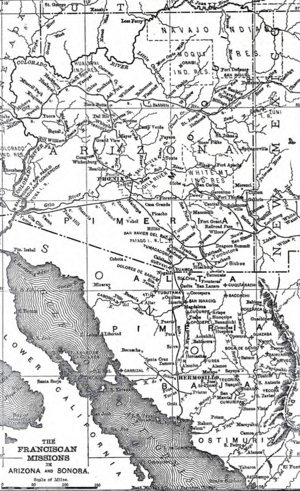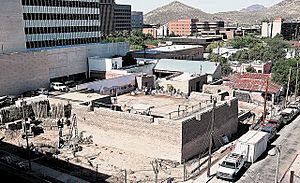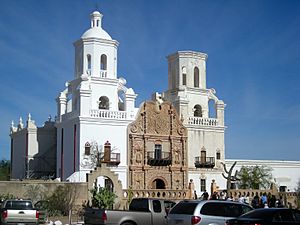Pimería Alta facts for kids
The Pimería Alta (say: Pee-meh-REE-ah AHL-tah) means 'Upper Pima Land' in English. It was a large area in the 1700s, part of what is now southern Arizona in the United States and northern Sonora in Mexico.
This region got its name from the Pima and O'odham (also called Papago) Native American groups who lived in the Sonoran Desert. The Pimería Alta is famous for the Spanish missions in the Sonoran Desert. These missions were built by Jesuit missionaries like Eusebio Kino in the late 1600s and early 1700s. In 1751, the Pima people had a big rebellion against Spanish rule.
Contents
What Does Pimería Alta Mean?
The name Pimería Alta first appeared in Spanish documents, especially from the Catholic Church. It described a large area where the Pima Native American people lived. The Spanish used this name, along with 'Pimería Baja' (Lower Pima Land), to show where different types of the Pima language were spoken.
Even though it wasn't a political area, its borders were generally known. It stretched from the Gila River in the north to the Altar River Valley in the south. To the west, it reached the Colorado River and the Gulf of California, and to the east, the San Pedro River Valley.
Who Lived There Before the Spanish?
Before the Spanish arrived in the late 1600s, many different Native American tribes lived in the Pimería Alta. These included:
- The Pápagos (now called the Tohono Oʼodham)
- Pimas, Sobaipuris, and Gileños (now called Akimel O’odham)
- Sobas and Areneños (possibly Hia C-eḍ Oʼodham)
- Yuman-speaking Coco-maricopas and Opas (Maricopas, or Pee Posh)
Other groups living nearby were the Jocomes, Apaches, Yumas (Quechan), Quíquimas (Halyikwamai or possibly Cocopah), Seris, Nébomes (Eudeves), and Ópatas.
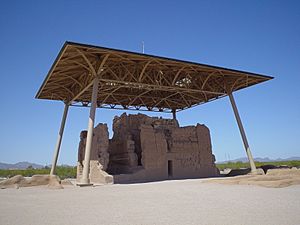
People have lived in this region for more than 3,000 years! Archaeologists have found old settlements and irrigation canals in river valleys from as far back as 2100 BC. Groups like the Hohokam, who are thought to be the ancestors of the O’odham, lived here from about AD 500 to AD 1450.
Most Native American groups in the Pimería Alta were semi-nomadic. This means they moved around but also stayed in one place for a while. They grew crops like beans, squash, and corn. They also gathered wild plants. These groups were skilled artisans and made beautiful pottery.
There is proof that they traded with people hundreds of kilometers away. For example, trade went as far west as the Gulf of California and as far south as Central Mexico. They traded items like copper bells, precious stones, and shells. In the 1600s, Apache groups also began to live in the region. Many ancient Native American settlements can still be seen today.
How Did the Spanish Arrive?
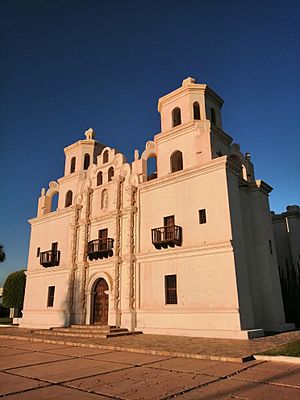
The first Spanish explorers and missionaries came to the Pimería Alta in the late 1600s. Father Eusebio Kino, a Jesuit missionary, arrived in 1687. He built his first mission, Nuestra Señora de los Dolores de Cósari, in what is now northern Sonora. Father Kino then started a network of more than a dozen missions in the region.
These missions had several purposes:
- They taught Native Americans about Christianity.
- They encouraged nomadic people to settle down and live in farming communities.
- They influenced Native Americans with Spanish religion and culture.
- Native Americans living at the missions provided labor. This labor was important for the missions to succeed.
Within the missions, Native American people had some power in their own councils, called cabildos. These councils had officers like alcaldes and gobernadores. These officers helped keep order and followed Spanish rules. Missionaries worked through these councils, which gave Native Americans some control over their daily lives. The land used by the missions was also legally tied to the Native American people, not the missionaries.
Spanish Control and Native Resistance
The Jesuit missions were a key part of Spanish settlement in the Pimería Alta. They helped the Spanish Crown and converted Native American groups to Christianity. The missions relied on Native American labor to grow food and make goods. As the Pimería Alta became more important, the Spanish also built military forts called presidios and started mining.
Even with the missions, the Spanish often faced resistance from Native Americans. Apache raids were a constant fear for the Spanish. The Pima people also rebelled at times, making the region a dangerous place for Spanish settlers.
For example, in 1751, the Pima people rebelled. A Spanish traveler wrote about how they attacked the missionary's house in Tubutama for two days, burning it and the church to ashes.
The Spanish often used force to deal with Native American resistance. They sent military expeditions and built presidios (military forts). Eight presidios were built in the region to protect against Apache and Seri raids. These forts often led to permanent Spanish settlements, like the Presidio San Agustín del Tucsón in Tucson.
However, not all Native Americans fought against the Spanish. Many found ways to live within the new Spanish system. They even used Spanish laws to solve problems. Sometimes, Native Americans living on missions were also attacked during Apache raids against the Spanish.
As more Spanish settlers arrived, they focused on farming and raising cattle near the scarce water sources in the Sonoran Desert. They also tried small-scale mining. But because of little water and the desert's geography, these efforts didn't create as much wealth as other parts of New Spain. So, they weren't very important to the Spanish government.
The economy in the Pimería Alta mostly stayed local. Markets were small and changed with new mining discoveries. This slow growth meant that private land ownership didn't spread as quickly as in other areas.
Things changed when the Jesuits were forced to leave in 1767. This was part of bigger changes called the Bourbon Reforms. Many missions then declined, and fewer Native Americans lived there. Meanwhile, Spanish settlements and presidios grew. As missions declined, private Spanish landowners started taking over lands that had belonged to Native American communities. However, some Native American communities continued to farm their original lands.
The Spanish way of life created a divide between Spanish landowners (hacendados) and Native American farmers. Land ownership, especially access to water, became a way to control people. These problems continued even after Mexico became independent.
After Spanish Rule
The Spanish colonization had a huge impact on the Pimería Alta. Spanish and Native American customs became part of life there, even after Mexico became independent in 1821.
After Mexico gained independence, its government tried to make Native Americans part of Mexican society. They gave Native Americans Mexican citizenship, which gave them political rights but took away their special status as 'Indians'. They also tried to involve Native Americans in local politics and gave small plots of land to families. These policies were different from the mission system, which had supported communal farming and some Native American self-rule. If these policies failed, the Mexican government sometimes deported Native Americans to other parts of the country (like during the Yaqui Wars) or used military force. By the early 1900s, Mexico started to work more cooperatively with Native American communities.
After the Mexican–American War ended in 1848, the Pimería Alta was still part of Mexico. But in 1853, the Gadsden Purchase moved the northern part of the Pimería Alta into the Arizona territory of the United States. The southern part stayed with Mexico.
The US government's approach to Native Americans was very different. They forced Native Americans to live on government-marked Indian reservations, separate from US settlements. This pushed Native Americans off their traditional lands. The US government's policy involved "individual landholding, compulsory education, and religious replacement." Mexican residents who lived in the area before the US took over faced challenges, too. Their land claims were often ignored or given to Anglo-American settlers. Later, African-Americans, Chinese, and other immigrant groups moved to the region for economic opportunities, especially with the copper mining boom and new farming. Today, reservations are still an important part of life for many Native American nations in the US.
What is the Legacy of Pimería Alta Today?
Much of the Pimería Alta is in the Sonoran Desert, which is a very diverse and wet desert. Even after the US took over the northern part, people continued to move and trade across the new border. This happened despite US rules on trade and migration, which started in the early 1900s.
The culture of Native American groups like the Tohono Oʼodham, Pascua Yaqui, Ak-Chin, and Gila River is still very strong. The San Xavier Indian Reservation, one of Arizona's largest, is in this region. You can also still see the old mission buildings and presidios in both Arizona and Sonora.
However, European and American settlement has had a big impact on the environment. Many rivers and water sources have dried up over time because of overuse, changes to the land, and climate change.
See Also
 In Spanish: Pimería Alta para niños
In Spanish: Pimería Alta para niños


